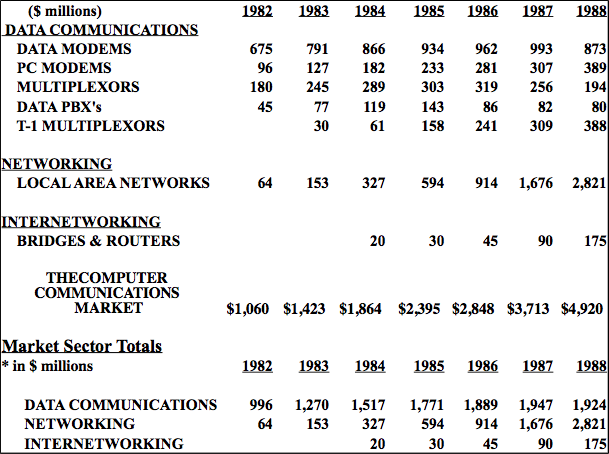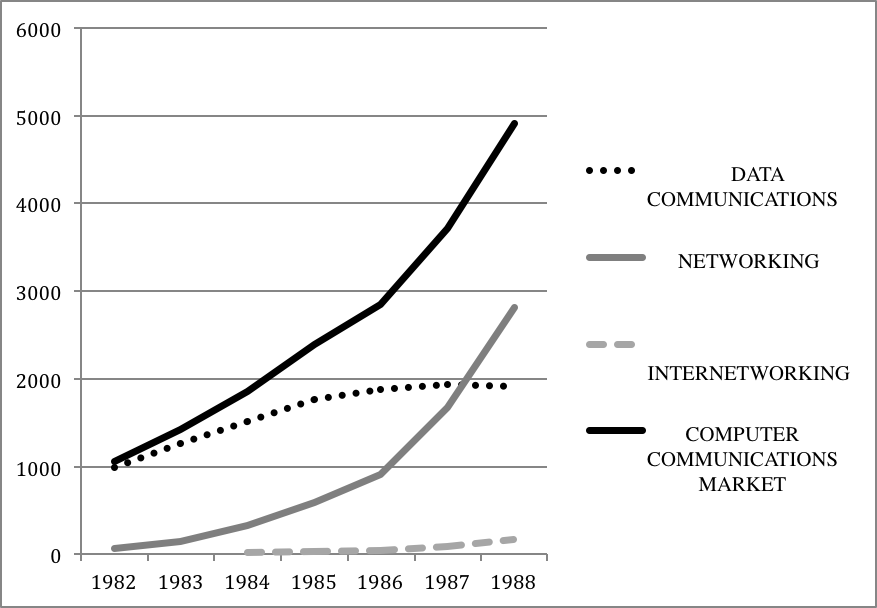Chapter 14 - Internetworking: Emergence 1985-1988
14.25 In Perspective
Now to switch our level of observation from the histories of individual Computer Communication firms to the perspective of the Market-structure as a whole. One important question is: How did the sales of products change over time, independent of the firms that sold them? (See Exhibit 12.18 - The Computer Communications Market-structure 1982-1988117) In the short span of four years, 1985 -1988, the revenue of the Computer Communications Market doubled, its growth rate leaping to 32% in 1988 on the back of the 68% growth in LANs. Obviously, not all products were doing as well as others, such as the stagnating category of Data Modems compared to LANs. It is easy to see why Codex was under pressure to find another product to fuel sales growth like LANs; sales of Data Modems having been flat since 1984. Or, if a company selling primarily multiplexers didn’t also sell T-1 Multiplexers, they were likely having problems, or were seeking to merge (Timeplex).
Exhibit 14.25.1 The Computer Communications Market-Structure 1982-1988

Frequently graphing data shows trends more clearly: While the total Computer Communications Market was growing rapidly, it was better to be a Networking, than Data Communications, company. (See Exhibit 12.19 Composition of the Computer Communications Market 1982-1988) Even that conclusion requires more investigation: for if a Data Communications firm focused exclusively on T-1 Multiplexers, then it participated in a market growing at 25% in 1988; even so, the leading firm in T-1 Multiplexers, NET, grew at the impressive rate of 50% in 1988; faster than many Networking companies.
Exhibit 14.25.2 Composition of the Computer Communications Market 1982-1988

In order to reveal the significant change waiting to happen, I will take advantage of my slow writing and make use of market results up to 2010. The size of the Internetworking Market in 1988 was only $175 million. Yet within ten years, the annual sales of one Internetworking firm - cisco Systems - will exceed the 1988 sales of Computer Communications (i.e., $5 billion). A few years later, the market capitalization of cisco Systems will explode to $555 billion, exceeding that of any company of its time, including AT&T and IBM!118 The irony is, in 1968, AT&T and IBM were more concerned with each other’s markets than the “insignificant” Computer Communications Market. Or maybe the delaying actions of IBM in the Networking Market in the early 1980’s were grounded in fear not ignorance. In both cases, AT&T and IBM didn’t take computer communications seriously, but entrepreneurs, and the start-ups they founded, did.
From earlier, the Emergent phase of both Data Communications and Networking was dominated by start-ups. From Exhibit 12.20 below (1988 Bridge and Router Installed Bases), only the Internetworking start-up cisco Systems held an early market share advantage in the two products defining the Internetworking Market – bridges and routers.119 Further analysis will reveal, however, that the “Other” category includes many start-ups.
The perspectives gained by analyzing macro conditions reveals that the early advantages Networking companies held in bridges did not easily transfer to routers. One question then becomes: if so much gain awaits the successful firm, and with the existing firms holding the advantages, how did the start-ups once again prevail? The insurmountable advantages routers had over bridges may not have been known, or maybe acknowledged, in 1985, or even 1988. The advantages of routers may also have been very difficult to master, or required making difficult choices. Some firms found merging into larger firms preferable to taking financial risks that could lead to failure.
Exhibit 14.25.3 1988 Bridge and Router Installed Base20
| Company | Installed Base Market Share |
|---|---|
| DEC | 28% |
| 2Com | 17% |
| Vitalink | 12% |
| Ungermann-Bass | 5% |
| Proteon | 4% |
| cisco Systems | 4% |
| Other | 28% |
| Total | 100% |
The answers to many of these questions, and more, will be found in the histories of the firms, and the dynamics of the Market Sectors, in the decades following 1988. Hopefully, the interested reader will return to this historical reconstruction, the interviews of 1988, the various Oral Collections of the Computer History Museum, and other archives. I hope you contact Marc Weber (marc@webhistory.org), who is Founder and Curator of the Internet History Program at CHM, if you have questions and to offer your historical material to CHM for Permanent preservation.
In Perspective: A Personal Remark
When conceived in 1987, I never would have imagined that I would be writing these words on the eve of 2014. That I am is an unmistakable signal that I should conclude. So as much as I care for this history, and the gracious individuals whom I interviewed, and met along the way, it is time to say good-bye.
From the beginning, my intention was to reconstruct this history through the experiences and recollections of those who were there. I wanted to capture the emotional nature of innovation and building companies. I felt my personal experiences with growing companies would enable me to write these histories with a unique point-of-view. When it came time to finish the final chapters, I found myself bogged down. Eventually, I realized that, in large measure, it was because I was not retelling the history through the “eyes” of the participants, but from reports and information I found in the trade press of the time. I didn’t have any interviews, or material from interviews, to use, for 85% of the interviewing was finished by the end of July 1985. A mistake I made, one I realized to late to correct.
I also made the decision early in the process to not include gossip or ungenerous comments in the text. I hope I have also eliminated any such remarks from the interviews. It certainly was my intention. I know I lost some intrigue in doing so, but I never felt the historical record was compromised.
The last issue is whether my knowing the turn of events after 1988 unduly influenced the reconstruction. Obviously, I hope not. I sent drafts of the chapters to those involved as well as having dialogue with many of the people whom I had interviewed to cross check my conclusions. Ultimately, only through the work of other historians will my work be proven useful. Lastly, I hope my largely unedited writing keeps the reader engaged, providing both an enjoyable and informative read. I certainly gained immeasurable regard for the work of historians as a result of this project.
That is it. Thank you, and I hope I have convinced you of the importance of these events.
Jim Pelkey
December, 2013
Kula, HI
- [117]:
See Market Research: Exhibit 2 Computer and Terminal Forecasts 1968-1988
- [118]:
“Cisco ascends to most valuable company”. CNET. February 8, 2000. https://www.cnet.com/news/cisco-ascends-to-most-valuable-company/ Retrieved December 20, 2013.
- [119]:
Even so, cisco Systems sold a meaningful number of Networking products, and might even have been classified as a Networking company.
- [120]:
Data Communications, July 1989, p. 63